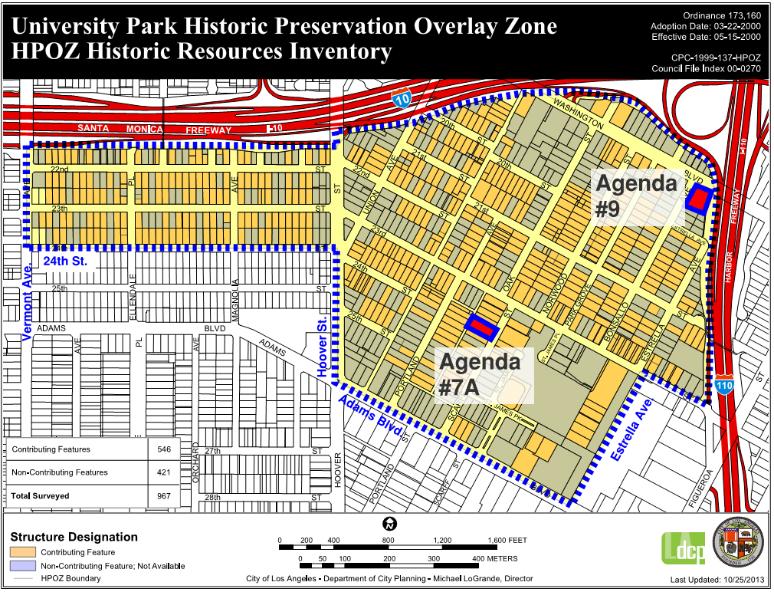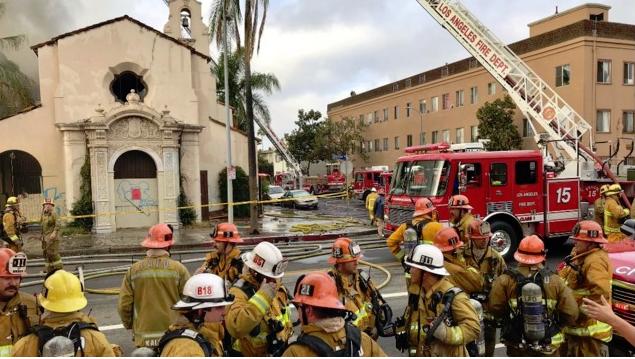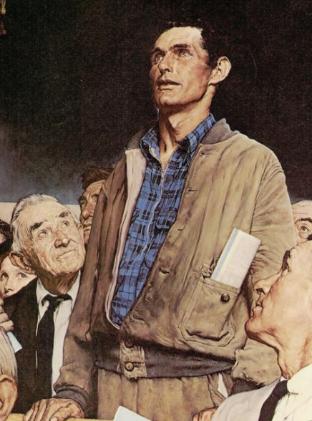Arch 549 – Heritage Conservation
Assignment #2 – Report – Cultural Heritage Commission Visit
October 22, 2018
Visit to a Local Preservation Commission Board Meeting
Context of HPOZ Commission Visit
Jay PlattThe intent of this report is to document my visit to a historic commission board meeting. On Tuesday, October 16, 2018, I attended the board meeting of the University Park Historic Preservation Overlay Zone board (UP-HPOZ). The meeting is scheduled for 6:45 PM.
University Park’s HPOZ is managed by the Office of Historic Resources, which is a unit of the city of Los Angeles’ Department of City Planning. The HPOZ area is located north of the USC campus; the northsouth boundaries are marked by Adams Blvd. and the Santa Monica Freeway; the east-west boundaries are book-ended at Vermont Avenue and the 110 Freeway.
First impressions, Finding out About Meeting, Experience
I’ve not been to a historic preservation board or commission meeting prior, so I was unsure what to expect. A Public Notice1 posted on the city’s webpage for Office of Historic Resources highlights the UP-HPOZ board’s meeting date, with an agenda listing only 3 business items.
Finding out about the UP-HPOZ was relatively effortless and navigable with just 3 mouse clicks. The web page for the city’s Office of Historic Resources lists 36 official HPOZ areas.2 Each listing links to information on that zone’s specific board meeting agendas. In contrast, locating the physical address took a bit more guess work, and leg work, an effort that I would appreciate was well worth. A section on the board agenda notes that the address is at “City Living Realty, 2316 ½ S. Union Ave,”3 specifically flagging that the meeting room is “upstairs”, and to “follow directions near door”.4 Arriving 30 minutes early, I intended to find the door and signage, but was a bit confused because there was no direction at door; the one entry glass door leading to stairs up was locked. I walked the building perimeter to make sure this was in fact the main entry. So I knocked,
1 Public Notice, Board Meeting Agenda, University Park Historic Preservation Overlay Zone Board Meeting, office of Historic Resources, LA City Planning Dept., October 16, 2016
2 Office of Historic Resources, Historic Preservation Overlay Zones (HPOZ’s), City of L.A., Dept. of City Planning, website https://preservation.lacity.org/hpoz/la/university-park

3 Public Notice, Board Meeting Agenda, UP-HPOZ
4 Public Notice, Board Meeting Agenda, Pg. 1.
Arch 549 – Heritage Conservation
Assignment #2 – Report – Cultural Heritage Commission Visit October 22, 2018
Jay Plattand knocked louder. Now 15 minutes away from start of board meeting, I could see a hunched older man wearing denim overalls coming down the stairs to unlock the door; he greeted me with a warm smile and a handshake, asking who I was and what I was doing attending the HPOZ board meeting. His name is Jim. He tells me that he’s a former UP-HPOZ board member back when it was first created via a city ordinance5 in the early 2000’s. Jim mentioned that he’s there now as a member of the public to speak on Agenda item #7A.
A description of pending action for each of the 3 agenda items is so laconic that it gives no indication whether the issue would put one to sleep or generate buzz. Jim invited me in while he posted on the door’s street side the public notice and directions to the UP-HPOZ board’s 2nd floor meeting room, teasing that I was in for “an education” in heritage preservation. I was intrigued.
Setting of Meeting Room & Place Context
The UP-HPOZ board meets in a narrow private office suite on the 2nd floor of a building on the north east corner of Hoover Street and 24th Street. The reception area displays educational and information handouts on the city’s HPOZ’s and “how-to” flyers on requesting an “Environmental Review” and requesting a “Design Review Determination.” Beyond is a rectangular proportioned main office area facing the street windows, with a couple of private desks; there is a room of similar rectangular layout at back office area where the board sits, but is windowless, with both spaces connected by a narrow and long intermediate hall converted for public seating, wide enough to fit one row of five chairs along each opposite wall leaving enough space in between for one person to pass by. This quirky room configuration severely constrains the public’s line of sight of the board members and proceedings, but given the tight space, acoustics were not bad.
Attending Board members included Chairperson Jean Frost (facing the public), members David Raposa and Mark Malan, as well as Board Architect Steven Fader (Board member David Raposa is owner of City Living Realty,6 the private office where UP-HPOZ board meets). I sat near the front row of the narrow passage facing the board; across from me Jim sat quietly, comfortable in his denim overalls.
Meeting Format
Chairperson Frost offers a warm welcome. She calls the meeting to order at exactly 6:45 PM, quickly cites quorum. Noticing that key applicants tied to agenda items #6B and #7A were not yet present, Chair Frost buys time by taking a few minutes to address the public. She looks surprised after noticing what is perhaps a larger than expected audience. Mrs. Frost moves to the “Introduction” part of the agenda, taking extra pains to inform the public about the “Purposes of the HPOZ”,7 of the board’s work, of “roles of the Board and City Staff,
5 University Park Adopting Ordinance #173160, City of Los Angeles, Dec. 12, 2000(https://preservation.lacity.org/hpoz/la/university-park)
6 Meet the Agent, City Living Realty (http://www.citylivingrealty.com/agents_DRaposa.php)
7 Public Notice, Board Meeting Agenda, Pg. 1.
Arch 549 – Heritage Conservation Jay Platt

Assignment #2 – Report – Cultural Heritage Commission Visit October 22, 2018
and Meeting procedure” which follows Robert’s Rules of Order. She also mentioned that the basis of the HPOZ’s criteria is the Secretary of the Interior’s (SoI) standards for rehabilitation.
Cases Heard, Issues Discussed

Jean Frost seemed like an efficient Chairperson, and did not deviate from the meeting Agenda, though she did shuffle the order of two key items to accommodate a late show by one of the applicants. Of the 3 agenda items, the first was a no show; and the 2nd for item #7A was running late, which we’ll come back to.
The Board Chairperson then jumps out of sequence to the third business item, agenda #9, listed under “Other Business” and described as “Update on Pierce Brothers Mortuary”, a wording so devoid of any meaningful reference, that it well masked the true magnitude of the issue. Board member David Raposa starts delivering his update report in an oddly detached monotone. I realized that the “update” is in fact referring to the aftermath of a blazing inferno that destroyed a key Historic-Cultural Monument earlier this month during the morning commute on October 4, 2018. Ground zero for the smoke plume was University Park HPOZ. The fire was so intense that the smoke column was visible for miles around, likely seen by hundreds of thousands of morning commuters and city residents, if not millions, with hovering media helicopters delivering live newsfeeds. How does a Board dedicated to historic preservation mourn such a loss? It occurred to me that a monotone voice is one way to cope before the public. The sad and tragic high-profile destruction by fire of the Pierce Mortuary building was reported by the L.A. Times, headlined “Fire rips through abandoned church near downtown L.A., destroying historic building”.8
Speakers, Deliberation and References to Standards
Once done with the Pierce Mortuary update, Chairperson Frost returns to normal order with agenda item #7A, recognizing that applicant, a developer, just walked in and takes a seat at the Board’s table, with his back to the public. This is when I notice that Jim’s foot starts a nervous tap, signaling subconsciously that something is about to come down. My lesson in historic preservation according to Jim was about to get underway. I would soon realize just
Arch 549 – Heritage Conservation
Assignment #2 – Report – Cultural Heritage Commission Visit October 22, 2018
how entertaining and educational Roberts Rules of Order would be.
Jay PlattChairperson Frost gives a brief description of the main issue. The developer is proposing to build 7 new condominium units on an infill lot at 2323 and 2325 ½ Scarf Street. She notes that the project has been before this same board back in the early 2000’s; more importantly, the project was approved, but that the developer did not proceed to construction phase due to the economic crisis of the mid-2000’s. So the 7-unit condo project is now back on. What we all understood but goes unsaid is that the fate of the project rests with this Board. The Planning Department requires HPOZ’s “Certificate of Compatibility” as a condition of approval. The board members have copies of the updated plans sitting on the table. During the first HPOZ review more than 10 years ago, the board seemed to have no doubts about the merits of the project fitting in and meeting the SoI’s criteria and of the HPOZ. This time around, there seemed to be plenty of doubt, telegraphed by Jim’s body language, giving advance notice of the stance he would take during public comment regarding the proposed development project.
Next, the Chairperson invites public comment, specifically addressing the 7-unit development. Jim’s foot stops tapping, allowing him to balance as he sits up, straightens his back and introduces himself, which is when I learn that his last name is Childs. Jim speaks; his tone is clear and unemotional with a trained cadence as if a broadcast news anchor except without any notes or teleprompter. Clearly Jim is well informed about the Secretary of the Interior’s standards as well as the applicability to this project, and demonstrates a full comprehension of the city’s planning approval process. Jim’s denim overalls might as well be a power suit and tie, because Jim peels away the flaws in the developer’s project in a professional and compellingly logical progression of reason points. Mr. Childs remains in a solid stance (resembling Norman Rockwell’s guy in “Freedom of Speech”) while revealing that he was a board member on the UP-HPOZ back in 2006 when this project was first approved. Jim recounts that he even voted for the project then, but that the board was not mature enough to ask the right questions then, or sufficiently sophisticated to apply the Secretary of the Interior’s standards in a more appropriate way. This is a sensational revelation by Jim. Thus, he continues, the decision to approve was faulty, and he urges this HPOZ board to reject the project and correct the past mistake. Jim’s revelation is designed to validate his claim by layering an unimpeachable varnish on his street credibility. The impact of Jim’s comments are felt as lethal. Seeing no other public speaker, he takes his seat.
Following Robert’s Rules, Chairperson Frost then allows the developer to make his case. The developer explains that his proposed design is compatible with the surrounding historic character, massing, open space and architectural styles. He notes that his design is Craftsman in an attempt to blend with the predominant style.
Chairperson Frost then opens up discussion to Board members. Initial questions focused on small items, then board members David and Mike progressively built up to broader, more fundamental critiques and tougher

Arch 549 – Heritage Conservation
Assignment #2 – Report – Cultural Heritage Commission Visit
October 22, 2018
Jay Plattquestions, many of them quite uncomfortable for the developer. Later, in a key exchange, the developer’s answer to an unrelated question completely contradicted his response to an earlier question. Board member David Malan was frank in questioning the developer’s motive in deploying a draftsman’s trick to make the floor plan appear as if a 4th bedroom was not a bedroom at all, but rather a large unusually over-sized walk-in closet that just conveniently happens to also include a bathroom.
The implication is that there was some sort of deceit going on. This marked a turning point in the board’s tone. A 4th bedroom bumps up the parking requirements per planning and zoning ordinances. Clearly there is an attempt here to add a 4th bedroom, and clearly there is not sufficient parking provided, but more importantly, the over-sized 4th bedroom space compounds an even larger problem that is in the HPOZ Board’s jurisdiction: the accumulated additional area due to oversizing the walk-in closet triggers a domino effect which bulks up the building massing resulting in unintended consequences. To Board members and Chairperson, this bulking of mass is what renders the project inconsistent with the neighborhood pattern.
Chairperson Frost repeated the following same question multiple times, rephrasing it slightly differently each time, asking the developer if he understood that this HPOZ board meeting is a new process, and that the old board meeting’s approval from 2006 is no longer valid. The developer responded each time that, “yes”, he was clear of the process. The developer reminded the board that the old design was for 8 units; this design, which has one unit less, is evidence of developer’s voluntary and seemingly good-will effort at scaling back from the allowed density in order to attempt to dovetail with the predominant community pattern. Finally, the developer’s response to Board member Mark Malan’s inquiry about a 6-foot high cement block wall served to expose the developer’s intent as a straightforward attempt to deceive the planning, fire department and the HPOZ board. Not only did the developer fail to make a compelling case for approval of his 7-unit condo project, but he lost credibility with the HPOZ board. The public, meaning Jim, extended no sympathies to the developer. Board member Malan’s closing of the issue by stating that the design “simply does not comply with the preservation plan”, was backed up with a comprehensive and quantifiable points list, the majority of which were enumerated by Jim’s carefully crafted litany.
Board member David Raposa seconded a motion put forth by Chairperson Frost which called to send a recommendation to the zoning administrator that rejects the 7-condo project on the justified basis that it does not meet criteria of the HPOZ. Additionally, Mrs. Frost directed the board to send a letter to the zoning administrator requesting to review the condition of the 4th bedroom and dependent parking requirements.
Take-Aways & Summary
The board’s action that evening seemed to the public to have been fatal for the developer’s condo project. However, the developer was not phased, nor did he show any emotion either way. Chairperson Frost and board members Malan and Raposa were fair and reasonable in their assessment, backed by well-reasoned points, and offered that the developer can return with a revised plan that responds with architectural elements more aligned with the sensitive historical character of the neighborhood.
Ramon Hernandez
Arch 549 – Heritage Conservation
Assignment #2 – Report – Cultural Heritage Commission Visit
October 22, 2018
Jay Platt
To put the HPOZ Board’s burden in perspective, the city’s Office of Historic Resources states on its web page that the “University Park contains one of the highest concentrations of City Historic-Cultural Monuments of any HPOZ in Los Angeles.”9 The University Park HPOZ Preservation Plan states that the boundary encompasses 620 parcels, of which 436 lots are of “contributing” historic value to the HPOZ.10 This proposed 7-unit development is surrounded by a high concentration of “contributing” buildings, making it quite challenging for the developer. Ultimately, the developer’s sleight of hand was more consequential in cementing the HPOZ board’s decision to reject the 7-condo project.
Overall, I got the impression that the University Park’s HPOZ board and other active community members like Jim, care deeply about protecting the community’s historical legacy and take their responsibility as stewards with utmost earnestness. It may appear to a developer that the UP-HPOZ board carries an antidevelopment chip on its collective shoulders, but in fact they are for development that is informed with a longterm view. It is a strategy that any short-term vision developer would seem to want to avoid. Observing the board’s actions and the thoughtful study and deliberation of projects before them, and their engagement with the public, I realized that to HPOZ board and community members, “value” means one thing, while to a developer, “value” is measured differently. Helping to bridge these two different perceptions and align their goals rests heavily on interpretation of Secretary of Interior guidelines. Jim was correct: the evening’s University Park HPOZ board meeting delivered on his promise: It was an education.
9 Office of Historic Resources, web page.
10 University Park HPOZ Preservation Plan, July 14, 2005, Section 7.3, Pg. 28, Introduction to University Park HPOZ Architectural Styles; (https://preservation.lacity.org/sites/default/files/UP%20PreservationPlan%20Final%20Pt1_0.pdf)
Ramon Hernandez
Professor:
Arch 549 – Heritage Conservation Jay Platt
Assignment #2 – Report – Cultural Heritage Commission Visit
October 22, 2018
Works Cited
1. Public Notice, Board Meeting Agenda, University Park Historic Preservation Overlay Zone Board Meeting, LA City Planning Dept., office of Historic Resources, October 16, 2016, 6:45 Pm https://planning.lacity.org/InternetCalendar/pdf.aspx?Id=62083
2. Office of Historic Resources, Historic Preservation Overlay Zones (HPOZ’s), City of L.A., Dept. of City Planning: https://preservation.lacity.org/hpoz
3. Ordinance No. 173160, Adopted 12/9/2000, Historical Overlay Zone in University Park, City of Los Angeles.
4. City of L.A., Dept. of City Planning, Ordinance on Historic Preservation Overlay Zones, https://preservation.lacity.org/files/Citywide%20HPOZ%20Ordinance.pdf
5. University Park HPOZ Preservation Plan, July 14, 2005; https://preservation.lacity.org/sites/default/files/UP%20PreservationPlan%20Final%20Pt1_0.pdf
